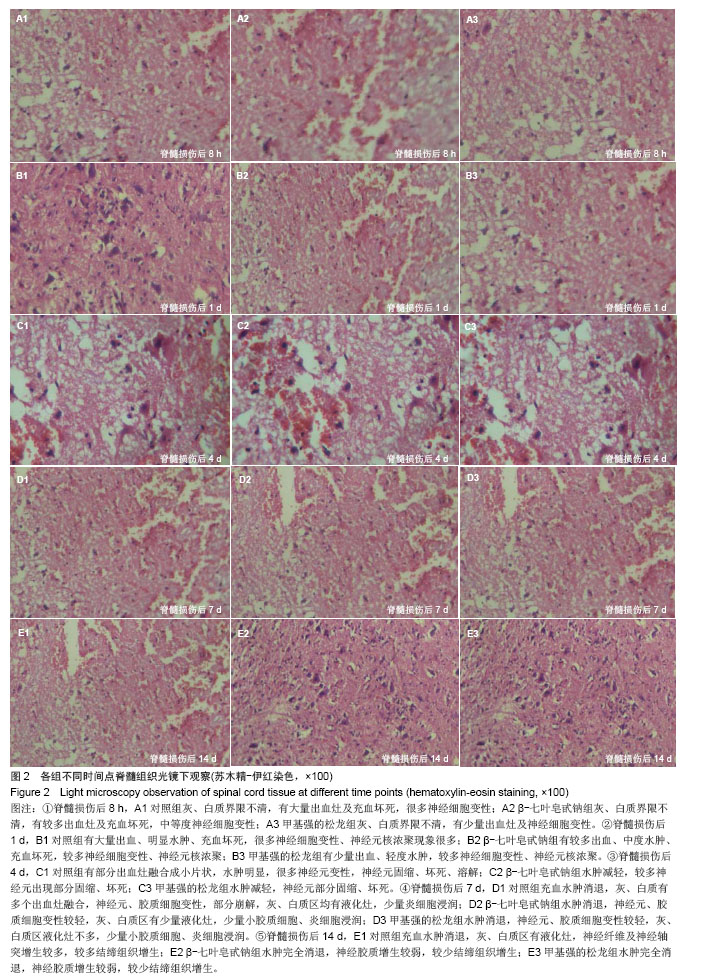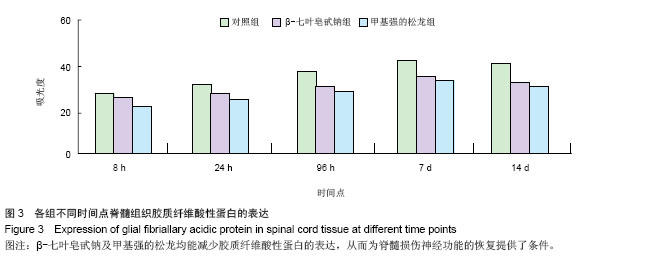| [1]Munts AG, van der Plas AA, Ferrari MD,et al.Efficacy and safety of a single intrathecal methylprednisolone bolus in chronic complex regional pain syndrome.Eur J Pain. 2010; 14(5):523-528.
[2]胥少汀.脊髓损伤基础与临床[J].北京:人民卫生出版社,2002.
[3]Bunge MB.Novel combination strategies to repair the injured mammalian spinal cord.J Spinal Cord Med. 2008;31(3): 262-269.
[4]Sasaki M, Hains BC, Lankford KL,et al.Protection of corticospinal tract neurons after dorsal spinal cord transection and engraftment of olfactory ensheathing cells.Glia. 2006; 53(4):352-359.
[5]Allen WE 3rd, D'Angelo CM, Kier EL.Correlation of microangiographic and electrophysiologic changes in experimental spinal cord trauma.Radiology. 1974;111(1): 107-115.
[6]Rivlin AS, Tator CH.Objective clinical assessment of motor function after experimental spinal cord injury in the rat.J Neurosurg. 1977;47(4):577-581.
[7]Fukaya C, Katayama Y, Kasai M,et al.Evaluation of time-dependent spread of tissue damage in experimental spinal cord injury by killed-end evoked potential: effect of high-dose methylprednisolone.J Neurosurg. 2003;98 (1 Suppl): 56-62.
[8]Lee KB, Choi JH, Byun K,et al.Recovery of CNS pathway innervating the sciatic nerve following transplantation of human neural stem cells in rat spinal cord injury.Cell Mol Neurobiol. 2012;32(1):149-157.
[9]Bareyre FM.Neuronal repair and replacement in spinal cord injury.J Neurol Sci. 2008;265(1-2):63-72.
[10]Yazdani SO, Pedram M, Hafizi M,et al.A comparison between neurally induced bone marrow derived mesenchymal stem cells and olfactory ensheathing glial cells to repair spinal cord injuries in rat.Tissue Cell. 2012;44(4):205-213.
[11]Fehlings MG, Nguyen DH.Immunoglobulin G: a potential treatment to attenuate neuroinflammation following spinal cord injury.J Clin Immunol. 2010;30 Suppl 1:S109-S112.
[12]Hsu CY, Dimitrijevic MR.Methylprednisolone in spinal cord injury: the possible mechanism of action.J Neurotrauma. 1990;7(3):115-119.
[13]Anderson DK, Means ED.Iron-induced lipid peroxidation in spinal cord: protection with mannitol and methylprednisolone. J Free Radic Biol Med. 1985;1(1):59-64.
[14]Hall ED, Yonkers PA, Taylor BM,et al.Lack of effect of postinjury treatment with methylprednisolone or tirilazad mesylate on the increase in eicosanoid levels in the acutely injured cat spinal cord.J Neurotrauma. 1995;12(3):245-256.
[15]鹿寒冰,李晓宾,董瑞国,等.β-七叶皂甙钠对实验性脑梗死大鼠脑水肿的影响[J].中华脑血管病杂志:电子版, 2013,7(4): 181-186.
[16]程鹏,冯斌,鞠躬. β-七叶皂苷早期应用对大鼠脊髓损伤的保护作用[J].神经解剖学杂志,2011,27(2):119-123.
[17]王金光,郑启新,郭晓东.重组人红细胞生成素与β-七叶皂甙钠治疗大鼠脊髓损伤的实验研究[J].中国脊柱脊髓杂志, 2011,13(11): 674-677.
[18]Wang Y, Ye Z, Hu X,et al.Morphological changes of the neural cells after blast injury of spinal cord and neuroprotective effects of sodium beta-aescinate in rabbits.Injury. 2010;41(7): 707-716.
[19]吴玉杰,沈康平,金文杰. β-七叶皂甙钠对脊髓损伤大鼠神经功能的保护作用[J].上海交通大学学报:医学版, 2007,27(8): 913-916.
[20]Schwab JM, Brechtel K, Mueller CA,et al.Experimental strategies to promote spinal cord regeneration--an integrative perspective.Prog Neurobiol. 2006;78(2):91-116.
[21]Gaviria M, Privat A, d'Arbigny P,et al.Neuroprotective effects of a novel NMDA antagonist, Gacyclidine, after experimental contusive spinal cord injury in adult rats.Brain Res. 2000; 874(2):200-209.
[22]Hall ED, Traystman RJ.Role of animal studies in the design of clinical trials.Front Neurol Neurosci. 2009;25:10-33.
[23]杨国柱,郭惠明,张晓慎,等.GFAP和MAP2 mRNA在缺血预处理与单纯缺血大鼠脊髓中的表达差异[J].广东医学, 2013,34(19): 2938-2941.
[24]李宽新,王维山,史晨辉.大鼠急性脊髓损伤后神经胶质酸性蛋白的表达意义[J].实用医学杂志,2011,27(22):4034-4036.
[25]Alexanian AR, Svendsen CN, Crowe MJ,et al.Transplantation of human glial-restricted neural precursors into injured spinal cord promotes functional and sensory recovery without causing allodynia.Cytotherapy. 2011;13(1):61-68.
[26]Ekmark-Lewén S, Lewén A, Israelsson C,et al.Vimentin and GFAP responses in astrocytes after contusion trauma to the murine brain.Restor Neurol Neurosci. 2010;28(3):311-321.
[27]Vos PE, Jacobs B, Andriessen TM,et al.GFAP and S100B are biomarkers of traumatic brain injury: an observational cohort study.Neurology. 2010;75(20):1786-1793.
[28]杨青峰,龙在云,曾琳,等.大鼠脊髓缺血损伤后神经微丝及胶质纤维酸性蛋白的改变[J].中华创伤杂志,1998,14(S1):40-42.
[29]Cheng H, Wu JP, Tzeng SF.Neuroprotection of glial cell line-derived neurotrophic factor in damaged spinal cords following contusive injury.J Neurosci Res. 2002;69(3):397-405.
[30]Kawai H, Arata N, Nakayasu H.Three-dimensional distribution of astrocytes in zebrafish spinal cord.Glia. 2001;36(3):406-413.
[31]Tatagiba M, Brosamle C, Schwab ME.Regeneration of injured axons in the adult mammalian central nervous system. Neurosurgery. 1997;40(3):541-546.
[32]Hinkle DA, Baldwin SA, Scheff SW,et al.GFAP and S100beta expression in the cortex and hippocampus in response to mild cortical contusion.J Neurotrauma. 1997;14(10):729-738. |




.jpg)
.jpg)